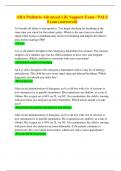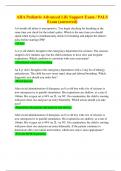Aha Study guides, Class notes & Summaries
Looking for the best study guides, study notes and summaries about Aha? On this page you'll find 99 study documents about Aha.
Page 3 out of 99 results
Sort by
AHA Pediatric Advanced Life Support Exam / PALS Exam (answered) 2024
AHA Pediatric Advanced Life Support Exam / PALS Exam (answered) 2024
AHA Pediatric Advanced Life Support Exam / PALS Exam (answered) 2024

-
AHA PALS Practice exam Questions and Answers 100% Correct
- Exam (elaborations) • 17 pages • 2024
-
- $12.49
- + learn more
1. A 5-year-old child presents with lethargy, increased work of breathing, and pale color. The primary assessment reveals that the airway is open and the respiratory rate is 30/min, with crackles heard on auscultation. The cardiac monitor shows sinus tachycardia at a rate of 165/min. The pulse oximeter displays an oxygen saturation of 95% and a pulse rate of 93/min. On the basis of this information, which of the following provides the best interpretation of the oxygen saturation of 95% by p...

-
AHA ACLS Written Test Questions and Answers 100% Correct
- Exam (elaborations) • 6 pages • 2024
-
- $7.99
- + learn more
You find an unresponsive pt. who is not breathing. After activating the emergency response system, you determine there is no pulse. What is your next action?Start chest compressions of at least 100 per min. You are evaluating a 58 year old man with chest pain. The BP is 92/50 and a heart rate of 92/min, non-labored respiratory rate is 14 breaths/min and the pulse O2 is 97%. What assessment step is most important now?Obtaining a 12 lead ECG. What is the preferred method of access for epi ad...

-
AHA BLS Exam Review Questions and Answers 100% Correct
- Exam (elaborations) • 15 pages • 2024
-
- $9.99
- + learn more
1. When should the rescuer initially ensure that the scene is safe? a. When the rescuer first sees a potential victim b. After the rescuer activates the emergency response system c. As emergency medical services arrive on the scene d. After an AED that is attached to the victim delivers a shockA 2. As soon as an AED becomes available, which of the following is the first step the rescuer should perform to operate the AED? a. Place the AED pads on the chest b. Deliver 2 rescue breaths befo...

-
AHA PALS Practice exam Questions and Answers 100% Correct
- Exam (elaborations) • 17 pages • 2024
-
- $15.49
- + learn more
1. A 5-year-old child presents with lethargy, increased work of breathing, and pale color. The primary assessment reveals that the airway is open and the respiratory rate is 30/min, with crackles heard on auscultation. The cardiac monitor shows sinus tachycardia at a rate of 165/min. The pulse oximeter displays an oxygen saturation of 95% and a pulse rate of 93/min. On the basis of this information, which of the following provides the best interpretation of the oxygen saturation of 95% by p...

-
AHA ACLS Written Test Questions and Answers 100% Correct
- Exam (elaborations) • 6 pages • 2024
-
- $7.99
- + learn more
You find an unresponsive pt. who is not breathing. After activating the emergency response system, you determine there is no pulse. What is your next action?Start chest compressions of at least 100 per min. You are evaluating a 58 year old man with chest pain. The BP is 92/50 and a heart rate of 92/min, non-labored respiratory rate is 14 breaths/min and the pulse O2 is 97%. What assessment step is most important now?Obtaining a 12 lead ECG. What is the preferred method of access for epi ad...

-
AHA BLS Exam Review Questions and Answers 100% Correct
- Exam (elaborations) • 15 pages • 2024
-
- $12.49
- + learn more
1. When should the rescuer initially ensure that the scene is safe? a. When the rescuer first sees a potential victim b. After the rescuer activates the emergency response system c. As emergency medical services arrive on the scene d. After an AED that is attached to the victim delivers a shockA 2. As soon as an AED becomes available, which of the following is the first step the rescuer should perform to operate the AED? a. Place the AED pads on the chest b. Deliver 2 rescue breaths befo...

-
AHA PALS Practice exam Questions and Answers 100% Correct
- Exam (elaborations) • 17 pages • 2024
-
- $13.99
- + learn more
1. A 5-year-old child presents with lethargy, increased work of breathing, and pale color. The primary assessment reveals that the airway is open and the respiratory rate is 30/min, with crackles heard on auscultation. The cardiac monitor shows sinus tachycardia at a rate of 165/min. The pulse oximeter displays an oxygen saturation of 95% and a pulse rate of 93/min. On the basis of this information, which of the following provides the best interpretation of the oxygen saturation of 95%...

Study stress? For sellers on Stuvia, these are actually golden times. KA-CHING! Earn from your study resources too and start uploading now. Discover all about earning on Stuvia





